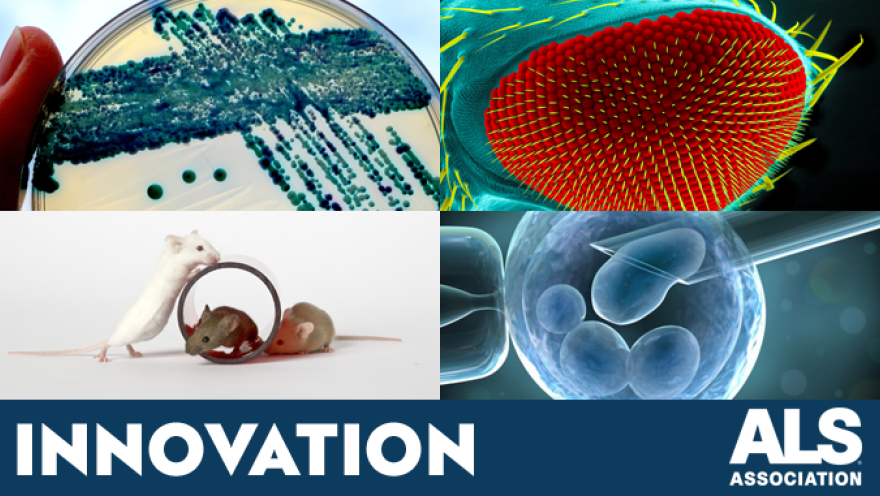Innovation plays a key role in The ALS Association’s fight to develop treatments and a cure for ALS and to empower people living with the disease to live their lives to the fullest. Throughout June and July, we have celebrated some of the key innovations helping us change the nature of ALS forever.
Research funded by The ALS Association helped develop the first mouse model that specifically expresses poly(GR), a type of dipeptide repeat protein associated with C9orf72, which uncovered a new ALS disease pathway. Dr. Leonard Petrucelli’s group at the Mayo Clinic in Jacksonville, Florida, recently published the research in Nature Medicine.
C9orf72 mutations, the most common cause of inherited ALS, cause the formation of abnormal RNA and proteins, called dipeptide repeat proteins, that spur toxicity in cells, specifically in motor neurons, the main cells that die during disease. Using their new mouse model, the group revealed that poly(GR) negatively impacts ribosomes, thus turning off protein synthesis. Poly(GR) also co-localized with stress granules, interrupting their normal function.
Stress granules play an integral part on how cells normally respond to stress, thus interrupting function is toxic to cells. Notably, in people with C9 ALS, the researchers found poly(GR), ribosomes, and stress granules localized in the same place in the brain, suggesting that disrupting interactions between the three proteins represents a potential ALS therapeutic target.
Funding innovative research like Dr. Petrucelli’s research is at the core of The ALS Association’s research program, which funds promising research across the entire research pipeline – from basic research up to and including phase II clinical trials, while spurring innovation along the way.
Harnessing innovative ideas, the first step along the research pipeline is essential to spurring innovation. Once a gene is discovered, new model organisms, such as mice, rats, microscopic worms, cell and motor neuron models, and more are developed based on the newly identified gene. Every new ALS gene discovery represents a new ALS therapeutic target. The more ALS therapeutic targets identified, the more likely an effective treatment will be found.
ALS disease models help us develop new treatments faster by better understanding current disease pathways, to discover novel disease pathways associated with new genes, and most importantly devel novel therapies based on newly identified target genes.
The ALS Association has funded the development of all major ALS model systems, many of which have been made available to ALS researchers around the without large licensing fees.
All major ALS animal models created, and disease pathways discovered to cause ALS were supported by funding from the Association both before and after the ALS Ice Bucket Challenge. Outlined below are only some examples of the major models and pathways the Association funded.
The ALS Association research dollars set the global agenda for ALS research and discovery to make a significant impact on ALS researchers’ studies across the research pipeline.
“[The ALS Association's] support helps us on so many levels. It excites us, invigorates us and validates us. But at same time, there is a strong sense of responsibility because this is money from someone that was most likely touched by this devastating disease. That level of trust means a lot and heightens our work.” (Dr. James Connor, Penn State Hershey Medical Center, Recipient of TREAT ALS™ Investigator-Initiated Award)
It is crucial that we keep the momentum going to continue to spur innovation across the research pipeline!
For more information about Dr. Petrucelli’s paper click here.
Paper citation:
Zhang YJ, Gendron TF, Ebbert MT, O’Raw AD, Yue M, Jansen-West K, Zhang X, Prudencio M, Chew J, Cook CN, Daughrity LM, Tong J, Song Y, Pickles SR, Castanedes-Casey M, Kurti A, Rademakers R, Oskarsson B, Dickson DW, Hu W, Gitler AD, Fryer JD, Petrucelli L. Poly(GR) impairs protein translation and stress granule dynamics in C9orf72-associated frontotemporal dementia and amyotrophic lateral sclerosis. Nat Med. 2018 Jun 25
This article is not open access.


Join the conversation. Please comment below.